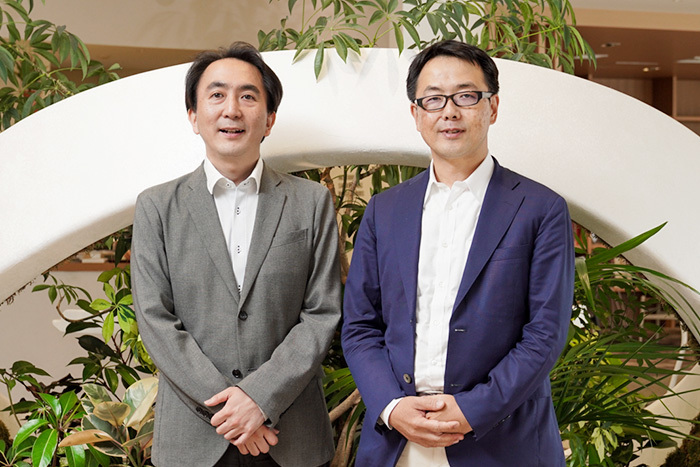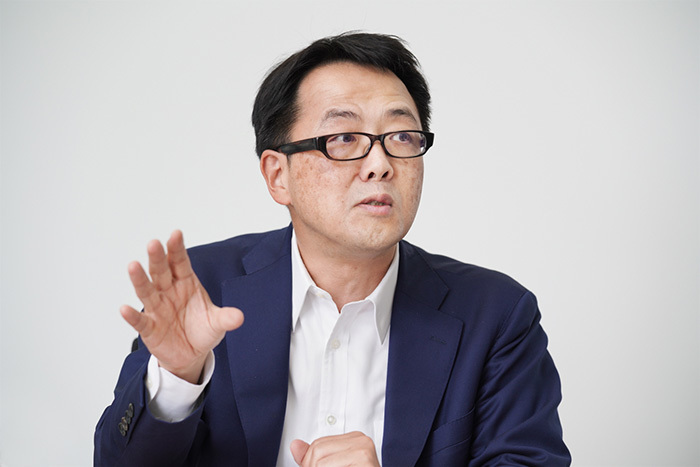In this series, based on the results of joint research and studies conducted by Video Research Ltd. and Dentsu Inc., we have examined how to design the video viewing environment for consumers across television and smartphones.
In this final installment, looking back on the series, Mr. Ken Kameda of Video Research Ltd.'s Hito Research Institute and Mr . Shota Ogura of Dentsu Inc.'s Future Forecasting Support Lab discuss the role television must play in the Reiwa era, centered on the theme of "connecting."

From left: Mr. Ken Kameda of Video Research Ltd., Mr. Shota Ogura of Dentsu Inc.
From Showa to Heisei to Reiwa: The Evolution of the Television Set's Role
Ogura: Through our joint research, we've been able to closely observe how people's viewing behaviors have changed with the advent of the internet and smartphones. While we broadly refer to it as "television," the role expected of it evolves with the times. Today, I'd like to explore the evolution and future vision of the television set's role with Mr. Kameda, who has long studied consumers' television viewing habits.
First, the Showa era was a time when many people shared excitement over common television content. I believe television sets served as a function connecting people's perspectives. There was only one TV per household, and the whole family watched the same screen together. The entire country watched the same programs. It became commonplace for major events to be viewed simultaneously not just domestically but worldwide, profoundly reshaping the world.
Kameda: That's right. People in the Showa era were deeply connected to television, and television programs and commercials could capture the needs of everyone.
Ogura: However, as the era shifted from Showa to Heisei, what consumers sought became increasingly diverse. The advancement of the "individual" era and the expansion of freedom for individuals to choose their preferred content represent the changes that occurred throughout the 30 years of Heisei.
Kameda: With the start of the Reiwa era, we now have a moment to look back and ask, "What kind of era was Heisei?" And indeed, we can reflect that it was truly an era of the individual. The television, once one per household, became one per person. Furthermore, the proliferation of personal computers and smartphones dramatically changed how we engage with video content. By the end of the Heisei era, we saw an increase in players beyond television, both in terms of devices and video content.
Of course, TV screens became thinner and picture quality improved. But the speed of digital technology's evolution was even faster, and the content environment surrounding consumers changed at a dizzying pace.
Ogura: The disposable time (time people can freely use at their own discretion) that was once dominated by television sets and TV programs is now being dispersed among social media and video-sharing services.
The "individual" seeks a kind of "efficiency." In Part 2 of this series, Mr. Ochiai from Video Research Ltd. reported on the reality of "time-performance viewing (Taipa viewing)" – where people consciously consider their disposable time and choose content that maximizes satisfaction within it.
"Time Performance" and internet technology are a good match. Consumers who "just want to watch anime" can spend all day watching anime via SVOD.
However, at the same time, I feel society is beginning to demand once again the function of "connecting" people, something television used to provide.
Kameda: I agree. Television, symbolized by the living room culture of the Showa era, has always been good at "bringing people together."
The large screen of the television set served as a shared screen, connecting families. Furthermore, television programs, through their simultaneity, connected people across Japan and around the world. I believe this unique character of television is being reevaluated, leading to a natural return to television's inherent role of "connecting."
Television sets are now expected to play a role in connecting people and devices.
Ogura: In this series, we've referred to both "television as a receiver" and "television programs as content" collectively as "television." However, I feel the very definition of the word "television" is now shifting. People watch internet content on TV sets, and conversely, watch TV programs on smartphones.
So, the unique character of television that emerges is its "connecting" function, isn't it? That is, everyone watching content with a sense of simultaneity on a large screen.
Kameda: Focusing on simultaneity, SNS has created something like a "virtual living room," connecting people gathered around the TV set and enabling communication through shared emotions. Watching soccer on TV while opening Twitter to tweet "Player XX just scored!"—isn't that a new form of the living room for our era?
Ogura:In Part 3 of this series, we revealed that consumers unconsciously switch between two types of information behavior: sharing collective interests (spreading) through group activities like watching TV together, and deepening personal interests (digging) via the internet or smartphones. While browsing SNS, one is in an "individual" state. But upon seeing someone else's post saying "There's an interesting show on," they turn on the TV and instantly join a group viewing. This free movement between "individual" and "group" is key.
Kameda: It doesn't force everyone to connect like in the Showa era. But pursuing the "individual" to the extreme, like in the Heisei era, can feel lonely, so people also want spaces where they can "gather." Finding that balance might be the essence of "Reiwa TV."
Ogura: On the other hand, the technology surrounding video viewing environments will continue to evolve. Within that, "future television" might not have a common schedule for everyone. Instead, programs tailored to each person's daily rhythm and interests could emerge—a sort of "personalized schedule."
Kameda: For instance, we could enter an era where AI understands each person's behavioral patterns and interests, suggesting what programs to watch from the moment they wake up until they return home from work. During the commute on the train, they might watch on their smartphone, and after returning home, during dinner, they might watch on the TV set – optimized content tailored to each individual throughout the day.
Of course, excessive personalization risks leading to biased information exposure. Therefore, alongside AI, we'll need to incorporate programming schedules crafted with high awareness by each TV station.
Ogura: That's great. Beyond the joy of selecting content you like yourself, as we've seen in this series, there's also the joy of having new perspectives proposed by broadcasters through programming. To make these two joys coexist, the viewing environment needs to become much more sophisticated.
In that sense, the "Möbius-type viewing environment model" proposed by Mr. Oku of Dentsu Inc. Media Innovation Lab in Part 4 of this series is highly instructive. It emphasizes the importance of a user interface (UI) that allows users to freely move between linear (TV broadcast) and non-linear (video streaming) services.
For example, consider the TV remote control: the number keys are in the center, with buttons arranged around them. For viewers, it would be more user-friendly if they could select their desired content—whether linear (TV broadcast) or non-linear (VOD)—in a flat, seamless manner.
Kameda: We want the act of watching a specific channel's TV program and watching your favorite VOD service to be seamlessly connected. Considering this, it makes you wonder if button-based remotes are always the optimal solution. Perhaps the future lies in a UI where thumbnails appear on a touch panel, similar to karaoke remotes.
Also, every household now has a jumble of devices—TVs, smartphones, smart appliances. I want the TV to become a command center, unifying these home devices to shape our lifestyle. The vision is controlling all appliances and monitoring their status through the TV.
Ogura: Some say smart speakers will fulfill that role in the future. However, when considering it as an information hub beyond just appliance control, the advantage of a "large screen" is significant. It's easy to imagine the television receiver becoming a large, open window within the home, connecting us to the outside world.
Kameda: The vision for "Reiwa TV" is a structure where the television set, as a device, takes on the primary role of "connecting information," supported by "television programs" as content. We expect it to play an important role in society.
Ogura: In recent years, the world has been called an era of fragmentation, and issues with overly personalized information environments, like filter bubbles, have also come under discussion. I hope television will update its inherent functions of "connecting people" and "connecting perspectives," evolving into a new "information environment" that meets the demands of Reiwa society. Thank you very much for today!









